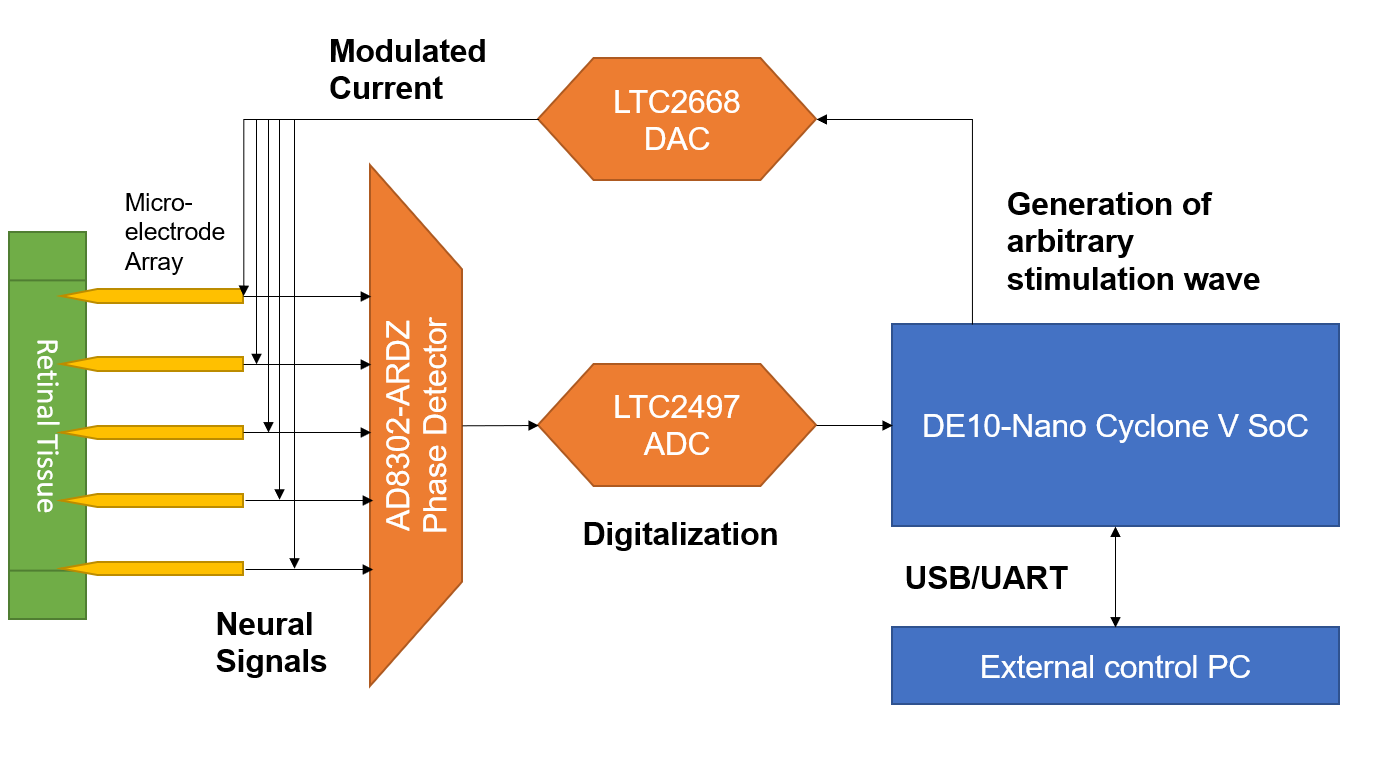
We try to build a FPGA based solution to stimulate retinal tissue phase dependently of the overlaying local field potentials. By this we want to increase the stimulation efficiency and thus decrease the power consumption of the device.
Project Proposal
1. High-level project introduction and performance expectation
Retinal photoreceptor degeneration accounts for the majority of vision losses in increasing age. Diseases such as age related macular degeneration or retinitis pigmentosa are the cause for a relevant decrease in the quality of life in affected patients, which is the reason why a lot of research is targeting their treatment. One possible therapy is the electrical stimulation of retinal ganglion cells to bypass the degenerated photoreceptors and send a neural signal directly to the brain. However the effect of low-frequency oscillations in retinal tissue strongly decreases the stimulation efficiency of this approach and drains the battery of possible implants in a short amount of time.
The stimulation efficiency can be determined by the number of action potentials evoked by the electrical stimulation. To increase it, a phase-dependent stimulation can be carried out, which sends out an electrical pulse during a specific phase angle of the low-frequency oscillations. This increase would lead to a much higher durability of possible implants and therefore to less resource consumption by surgeries, semiconductor fabrications and lithium batteries.
As the phase detection needs to take place in real-time, the use of a common PC or microcontroller to evaluate the measurements is not feasible, as the required speed can only be reached by a hardware implementation of the algorithms, such as on an FPGA. The combination of the Intel FPGA and the Analog Devices boards would offer us the possibility of high-resolution and high-performance recording and signal processing of the neural potentials. To verify the application of our system it will be tested in vitro in rd10-mice whose retinae feature similar characteristics as found in human retinal degenerations.
If successful, this project will lead to an improvement in stimulation strategies of degenerated retinal tissue. It can on one hand massively improve the visual quality of transmitted signals and on the other hand reduce the overall power consumption of an implant, making it feasible for long-term implantation.
2. Block Diagram

3. Expected sustainability results, projected resource savings
It is hard to define fixed performance parameters that should be reached by the project, as each tissue is different and it is not possible to standardize certain responses. The project is based on to pillars:
- Biological research and verification
- Technical inclusion into stimulation strategies
The scientific findings of our FPGA project will be used to improve stimulation strategies in the future, so at this point of time, e.g. reduction of system power consumption will not be the main target. However, as it will be necessary to detect a certain phase angle in a real-word implant as well, the FPGA-algorithms and extra hardware have to be designed in the most power-efficient way.
Therefore it can be expected that the total consumed computing power of the FPGA including all ADCs and DACs will be located in the mW range. The transmitted signal is then applied into the neural tissue, at this moment this is done via a direct wired link, however in future implants the wired link is not feasible anymore, as this would mean, that there had to be an implanted cable connection in a patient's eye. To solve this problem, the WiFi link of the DE10-Nano Cyclone V SoC can be used. It wil create a connection between the external signal processing unit (FPGA + ADCs + DACs) and the retinal implant consisting of a stimulator and an analog recording unit. The low-powered connection in combination with the much greater stimulation efficiency will lead to a drastical reduction in the implanted device's power consumption. As its main battery-draining process is the application of the stimulation current to the retina, this offers the greatest potential for power reduction. If the phase-dependent stimulation protocol is successful, it can lead to an improvement in stimulation efficiency by a factor of around 10. This means that the possible implant lifetime also can be improved by a factor of 10, resulting in a timespan of around 10 years, in comparison to one year feasible today.
Regarding this, a large amount of resources, working hours and energy will be saved, which makes our project very relevant for the ongoing research in retinal protheses.
4. Design Introduction
5. Functional description and implementation
6. Performance metrics, performance to expectation
7. Sustainability results, resource savings achieved
8. Conclusion
0 Comments
Please login to post a comment.